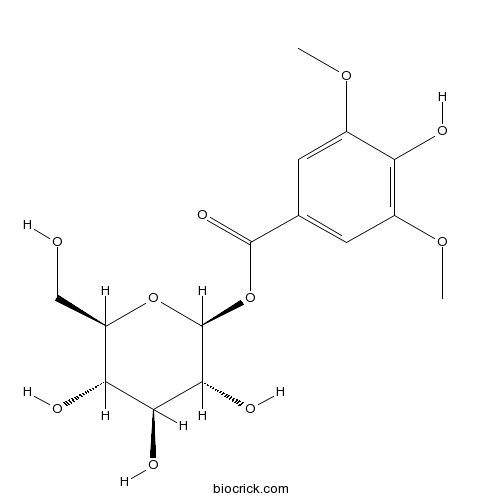Erigeside CCAS# 112667-09-1 |

Quality Control & MSDS
3D structure
Package In Stock
Number of papers citing our products

| Cas No. | 112667-09-1 | SDF | Download SDF |
| PubChem ID | 14132346 | Appearance | Powder |
| Formula | C15H20O10 | M.Wt | 360.3 |
| Type of Compound | Phenols | Storage | Desiccate at -20°C |
| Solubility | Soluble in Chloroform,Dichloromethane,Ethyl Acetate,DMSO,Acetone,etc. | ||
| Chemical Name | [(2S,3R,4S,5S,6R)-3,4,5-trihydroxy-6-(hydroxymethyl)oxan-2-yl] 4-hydroxy-3,5-dimethoxybenzoate | ||
| SMILES | COC1=CC(=CC(=C1O)OC)C(=O)OC2C(C(C(C(O2)CO)O)O)O | ||
| Standard InChIKey | CIYLTHWUJCCASO-APACUCGBSA-N | ||
| Standard InChI | InChI=1S/C15H20O10/c1-22-7-3-6(4-8(23-2)10(7)17)14(21)25-15-13(20)12(19)11(18)9(5-16)24-15/h3-4,9,11-13,15-20H,5H2,1-2H3/t9-,11-,12+,13-,15+/m1/s1 | ||
| General tips | For obtaining a higher solubility , please warm the tube at 37 ℃ and shake it in the ultrasonic bath for a while.Stock solution can be stored below -20℃ for several months. We recommend that you prepare and use the solution on the same day. However, if the test schedule requires, the stock solutions can be prepared in advance, and the stock solution must be sealed and stored below -20℃. In general, the stock solution can be kept for several months. Before use, we recommend that you leave the vial at room temperature for at least an hour before opening it. |
||
| About Packaging | 1. The packaging of the product may be reversed during transportation, cause the high purity compounds to adhere to the neck or cap of the vial.Take the vail out of its packaging and shake gently until the compounds fall to the bottom of the vial. 2. For liquid products, please centrifuge at 500xg to gather the liquid to the bottom of the vial. 3. Try to avoid loss or contamination during the experiment. |
||
| Shipping Condition | Packaging according to customer requirements(5mg, 10mg, 20mg and more). Ship via FedEx, DHL, UPS, EMS or other couriers with RT, or blue ice upon request. | ||
| Description | Standard reference |
| In vitro | Phenolic glycosides from Lindera obtusiloba and their anti-allergic inflammatory activities.[Pubmed: 23513723]Nat Prod Commun. 2013 Feb;8(2):181-2.Eight phenolic glycosides, tachioside (1), isotachioside (2), koaburaside (3), 2,6-dimethoxy-4-hydroxyphenyl-1-O-beta-D-glucopyranoside (4), 4,6-dihydroxy-2-methoxyphenyl-1-O-beta-D-glucopyranoside (5), a mixture of Erigeside C (6a) and salidroside (6b), and 6-hydroxyphenyl)-1-O-beta-D-glucopyranoside (7) were isolated from the stems of Lindera obtusiloba Blume. The structures of the isolates were determined by 1H-, 13C-NMR, COSY, HMQC, and HMBC spectroscopy. |

Erigeside C Dilution Calculator

Erigeside C Molarity Calculator
| 1 mg | 5 mg | 10 mg | 20 mg | 25 mg | |
| 1 mM | 2.7755 mL | 13.8773 mL | 27.7546 mL | 55.5093 mL | 69.3866 mL |
| 5 mM | 0.5551 mL | 2.7755 mL | 5.5509 mL | 11.1019 mL | 13.8773 mL |
| 10 mM | 0.2775 mL | 1.3877 mL | 2.7755 mL | 5.5509 mL | 6.9387 mL |
| 50 mM | 0.0555 mL | 0.2775 mL | 0.5551 mL | 1.1102 mL | 1.3877 mL |
| 100 mM | 0.0278 mL | 0.1388 mL | 0.2775 mL | 0.5551 mL | 0.6939 mL |
| * Note: If you are in the process of experiment, it's necessary to make the dilution ratios of the samples. The dilution data above is only for reference. Normally, it's can get a better solubility within lower of Concentrations. | |||||

Calcutta University

University of Minnesota

University of Maryland School of Medicine

University of Illinois at Chicago

The Ohio State University

University of Zurich

Harvard University

Colorado State University

Auburn University

Yale University

Worcester Polytechnic Institute

Washington State University

Stanford University

University of Leipzig

Universidade da Beira Interior

The Institute of Cancer Research

Heidelberg University

University of Amsterdam

University of Auckland

TsingHua University

The University of Michigan

Miami University

DRURY University

Jilin University

Fudan University

Wuhan University

Sun Yat-sen University

Universite de Paris

Deemed University

Auckland University

The University of Tokyo

Korea University
- Fragransin A2
Catalog No.:BCN6008
CAS No.:112652-46-7
- 1,7-Dihydroxyacridone
Catalog No.:BCN7275
CAS No.:112649-95-3
- BR-Xanthone A
Catalog No.:BCN6007
CAS No.:112649-48-6
- Garcinone E
Catalog No.:BCN3604
CAS No.:112649-21-5
- U-73122
Catalog No.:BCC5199
CAS No.:112648-68-7
- Dicyclanil
Catalog No.:BCC8938
CAS No.:112636-83-6
- Iso-mogroside V
Catalog No.:BCN3047
CAS No.:1126032-65-2
- 4-Allylpyrocatechol
Catalog No.:BCN6009
CAS No.:1126-61-0
- SKLB610
Catalog No.:BCC3647
CAS No.:1125780-41-7
- A 804598
Catalog No.:BCC6198
CAS No.:1125758-85-1
- Mps1-IN-1
Catalog No.:BCC5590
CAS No.:1125593-20-5
- 4-O-Methylepisappanol
Catalog No.:BCN3674
CAS No.:112529-37-0
- Oleonuezhenide
Catalog No.:BCN6011
CAS No.:112693-21-7
- IWR-1-endo
Catalog No.:BCC5102
CAS No.:1127442-82-3
- exo-IWR 1
Catalog No.:BCC7823
CAS No.:1127442-87-8
- Galanin (1-15) (porcine, rat)
Catalog No.:BCC5762
CAS No.:112747-70-3
- Clemastanin B
Catalog No.:BCC8152
CAS No.:112747-98-5
- Osthenone
Catalog No.:BCN4731
CAS No.:112789-90-9
- Letrozole
Catalog No.:BCC1063
CAS No.:112809-51-5
- Gatifloxacin
Catalog No.:BCC1064
CAS No.:112811-59-3
- 1-Cyclopropyl-6,7-difluoro-1,4-dihydro-8-methoxy-4-oxo-3-quinolinecarboxylic acid ethyl ester
Catalog No.:BCC8465
CAS No.:112811-71-9
- 1-Cyclopropyl-6,7-difluoro-1,4-dihydro-8-methoxy-4-oxo-3-quinolinecarboxylic acid
Catalog No.:BCC8464
CAS No.:112811-72-0
- Dynole 34-2
Catalog No.:BCC7891
CAS No.:1128165-88-7
- Methyllycaconitine citrate
Catalog No.:BCC6897
CAS No.:112825-05-5
Phenolic glycosides from Lindera obtusiloba and their anti-allergic inflammatory activities.[Pubmed:23513723]
Nat Prod Commun. 2013 Feb;8(2):181-2.
Eight phenolic glycosides, tachioside (1), isotachioside (2), koaburaside (3), 2,6-dimethoxy-4-hydroxyphenyl-1-O-beta-D-glucopyranoside (4), 4,6-dihydroxy-2-methoxyphenyl-1-O-beta-D-glucopyranoside (5), a mixture of Erigeside C (6a) and salidroside (6b), and 6-hydroxyphenyl)-1-O-beta-D-glucopyranoside (7) were isolated from the stems of Lindera obtusiloba Blume. The structures of the isolates were determined by 1H-, 13C-NMR, COSY, HMQC, and HMBC spectroscopy. To evaluate their anti-allergic inflammatory activities, the inhibitory effects of isolates (1-7) on histamine release and on the gene expressions of tumor necrosis factor (TNF)-a and interleukin (IL)-6 were examined using human mast cells; previous studies have reported that TNF-alpha and IL-6 release from mast cells is positively related to the severity of allergic symptoms. Of the tested compounds, koaburaside (3), 2,6-dimethoxy-4-hydroxyphenyl-1-O-beta-D-glucopyranoside (4), and (6-hydroxyphenyl)-1-O-beta-D-glucopyranoside (7) suppressed histamine release from mast cells as compared with gallic acid (positive control). In particular, 6-hydroxyphenyl)-1-O-beta-D-glucopyranoside (7) attenuated the gene expressions of the proinflammatory cytokines TNF-alpha and IL-6 in human mast cells. Our results support the notion that phenolic glycosides isolated from L. obtusiloba inhibit mast-cell-derived allergic inflammation, histamine, and proinflammatory cytokines.


